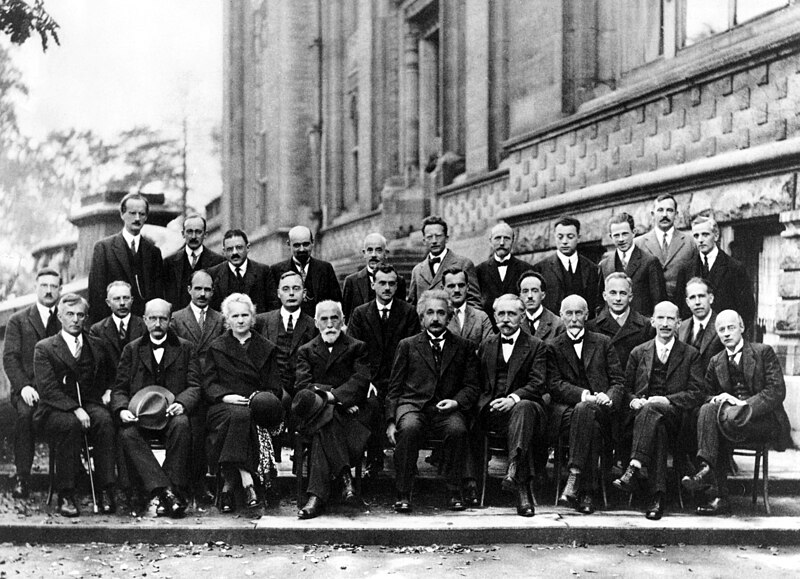
(she/her)
Whadjuk, Noongar Country
Twitter: @raffademichelis
Electronic devices, laser technology and imaging have become an integrated part of our existence; from facilitating all kinds of communication to improving the life quality of those living with critical health conditions. There is no aspect of our life that is completely device-free.
Have you ever wondered how we got to where we are? Did you know that everything in this entire technological universe around us has a common starting point – standing on the same ‘fundaments’ of science?
We have to go back to the 19th century, when people – mostly physicists, but not exclusively – took the Newtonian curiosity of how light interacts with matter to the next level. They started shooting particles and radiation at things, including having fun spinning a paddlewheel with cathodic rays into partial-vacuum glass tubes, the ancestors of cathode-ray tubes used in TVs decades later. They asked themselves questions like ‘what is matter?’ and ‘what is light?’, developing very fundamental science with no immediate applicability to produce anything useful. It was purely curiosity-driven research that, over the years, engaged more and more minds across the globe, motivated by their passion to just understand how nature works and by their amazement in discovering new and nearly unbelievable things. This is how they pushed the boundary of physics beyond its classical formulation and gave birth to the world of quantum physics and particle physics.
The specific details of these new branches of science usually trigger different reactions in people; they may look very scary to some and very exciting to others. Indeed, they are built on lots of abstract concepts and complicated mathematical formulations. This has resulted in several Nobel Prizes, but the most interesting part is they did not stop there. Research went on, gradually transitioning from equations and abstract concepts to real-life applications.
Inventions that no-one had imagined before suddenly became imaginable because of this new science. New ideas became new things, new things needed improvement through new experiments, new experiments brought more new theory that resulted in more new ideas for new applications and devices – and sometimes new troubles, due to the troublesome side of human nature. This domino effect went on until today, with my typing this story using one such device.
That curiosity-driven science grew, expanding beyond the boundaries of its original discipline and becoming an integral part of other fields of science, technology and medicine. For example, Wilhelm Röntgen’s discovery of X-rays (again, through playing with vacuum glass tubes) enabled Australian-born physicist Lawrence Bragg and his son William Bragg to set the foundation of X-ray crystallography, which itself later enabled Dorothy Hodgkin to figure out the structure of complex biomolecules like insulin and vitamin B12, and Rosalind Franklin to produce those diffraction images that were keys to understand the structure of DNA. This is a more than 50-year-long domino-science journey, whose benefits to humankind are unquestionable.
But still, it did not stop there. Theoretical and fundamental science developed in late 1800s and early 1900s set the fundaments for the two most revolutionary and broadly-applied inventions: the transistor and the laser, around the 1950s. And after that, the world as everyone knew it transitioned into a new era that we are still part of.
What were all these scientists, engineers, technicians and students thinking to achieve with their new science? Probably the most amazing things, but the pursuit of knowledge was the driving force. And “knowledge is power,” as Francis Bacon, one of the most influential philosophers who contributed to the scientific revolution, once stated.
What were people expecting from it? Comics and science fiction from the 20th century are a good showcase of how far the excitement, fear and imagination of the general public went thanks to this new science. New forms of energy, new materials, new treatments for diseases, time travel, superpowers – many of these became either a reality or a realistic hope, while some are (fortunately) just there to feed our imagination.
Fundamental research is often addressed with the diminishing terms of ‘blue sky research’ or ‘basic research’, which emphasise a perceived curiosity-over-usefulness approach and highlight a perceived irrelevance to everyday life’s complexity. It is of vital importance for the ‘fundamental’ aspect of fundamental research to emerge from the ashes of a funding system eroded by claims that what does not result in a short-term application is not worth any attention. Fundamental research means research that builds the fundaments – new fundaments for future ideas to stand on, new fundaments for future solutions we have not thought about yet, for solutions to future problems that we haven’t experienced yet. Think about m-RNA vaccines: most people thought they were of no relevance until COVID-19, when 30 years of Katalin Karikó’s hindered, underestimated research gifted us with a new, ready-to-use vaccine technology.
This is exactly what the handful of scientists depicted in the picture below, their collaborators and students did: they built the fundaments for us to invent devices and design solutions to problems they could not imagine yet.
Though there is still a long way to go in making sure this knowledge is used exclusively for good, and that its benefits are accessible to all humans, it is strikingly clear looking back 150 years later that it built the fundament to redesign all aspects of human life – bringing us to where we are now, at the edge of the quantum computing era, wondering what is going to be next.
This is just to say: thank you fundamental research!

© 2025 Australian Academy of Science